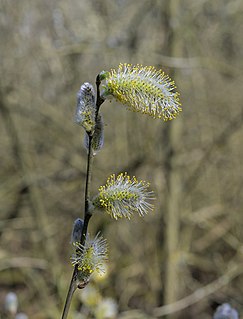
Salix caprea, known as goat willow, pussy willow or great sallow, is a common species of willow native to Europe and western and central Asia.

Salix purpurea, the purple willowpurpleosier willow or purple osier, is a species of willow native to most of Europe and western Asia north to the British Isles, Poland, and the Baltic States.

Salix fragilis, with the common names crack willow and brittle willow, is a species of willow native to Europe and Western Asia. It is native to riparian habitats, usually found growing beside rivers and streams, and in marshes and water meadow channels.

Salix discolor, the American pussy willow or glaucous willow, is a species of willow native to North America, one of two species commonly called pussy willow.
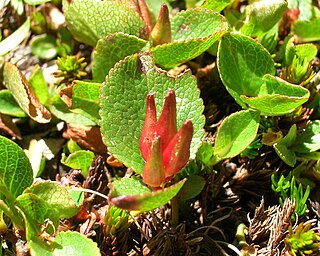
Salix herbacea, the dwarf willow, least willow or snowbed willow, is a species of tiny creeping willow adapted to survive in harsh arctic and subarctic environments. Distributed widely in alpine and arctic environments around the North Atlantic Ocean, it is one of the smallest of woody plants.

Salix cinerea is a species of willow native to Europe and western Asia.
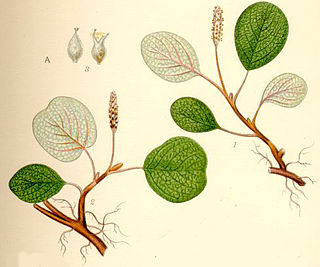
Salix reticulata, the net-leaved willow, or snow willow, is a dwarf willow, native to the colder parts of Europe, North America, and Northern Asia. It is found in the western United States, including the Sierra Nevada and Rocky Mountains. In Europe it extends south through the Carpathian Mountains and Alps to the Pyrenees and the mountains of Bulgaria and North Macedonia. It is common in Canada, Greenland and Finland, and present but rare in Scotland.

Sagina subulata is a species of Sagina, native to Europe, from Iceland south to Spain, and east to southern Sweden and Romania. It occurs on dry sandy or gravelly soils.
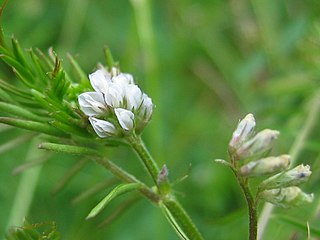
Vicia hirsuta or Ervilia hirsuta is a species of flowering plant from the large genus Vicia.

Salix lanata, the woolly willow, is a subarctic species of willow native to Iceland, the Faeroe Islands and Finland, through to eastern Siberia. In Scotland it can be found in only a few localities of Perthshire, Angus and Aberdeenshire, generally on rocky mountain sides at altitudes of 600–900 m (1,969–2,953 ft).
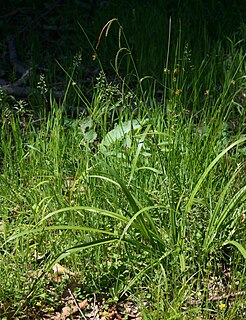
Carex pendula is a large sedge of the genus Carex. It occurs in woodland, scrubland, hedges and beside streams, preferring damp, heavy clay soils. It is sometimes grown as a garden plant because of its distinctive appearance.

Salix acutifolia, also known as Siberian violet-willow, long-leaved violet willow or sharp-leaf willow, is a species of flowering plant in the family Salicaceae, native to Russia and eastern Asia. It is a spreading, deciduous shrub or tree, growing to 10 m (33 ft) tall by 12 m (39 ft) wide. The young shoots are deep purple with a white bloom. The leaves are narrow, up to 10 cm (4 in) long. The catkins are produced in early spring, before the leaves. Older bark has a fine, netted pattern.

Lobelia urens has the English name of heath lobelia or acrid lobelia. It has a Lusitanian distribution running from Morocco along the Atlantic Coast to Belgium. It can be found in the islands of south Europe: Madeira, Tercia, Falia, Gibraltar. In Spain it is found in grazed pasture of upland valleys between 600 and 915 metres high. In Portugal it exists along the coastal plain, passing into the wet northern province valleys up to 800 metres. In north France it is found in lowland coastal areas. It is rare in Britain and found in South and South West of England in lowland areas up to 210 metres high. It is not threatened in Europe.
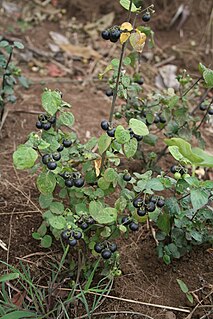
Solanum scabrum, also known as garden huckleberry, is an annual or perennial. The origin of the species is uncertain, although Linnaeus attributed it to Africa, but it also occurs in North America, and is naturalized in many countries. In Africa it is cultivated as a leaf vegetable and for dye from the berries.
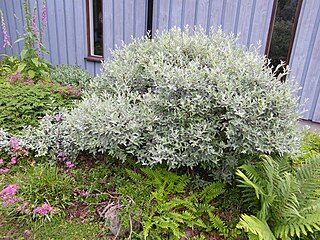
Salix lapponum, the downy willow, is a low, much-branched shrub having a wide distribution in Northern Europe, eastwards to the Altai and western Siberia, and is found as far south as the Pyrenees and Bulgaria. In Scotland, UK, it can be found on rocky mountain slopes and cliffs, generally at altitudes of 200–900 m (660–2,950 ft). It grows to a height of 1.5 m (4.9 ft).

Cyclachaena xanthiifolia, known as giant sumpweed, or rag sumpweed is a North American plant species in the sunflower family, Asteraceae. It is the only species in the genus Cyclachaena. Giant sumpweed is believed to be native to the Great Plains but is now found across much of southern Canada and the contiguous United States, though rarely in the Southeast.

Salix eleagnos the bitter willow, olive willow, hoary willow, rosemary willow, or elaeagnus willow, is a species of flowering plant in the family Salicaceae, native to central and southern Europe and south west Asia. Growing to 3 m (10 ft) tall by 5 m (16 ft) broad, it is an erect bushy deciduous shrub with narrow grey-green leaves up to 20 cm (8 in) long, which turn yellow in autumn (fall). The green catkins, 3–6 cm (1–2 in) long, appear with the leaves in spring, male catkins having yellow anthers.

Dactylorhiza majalis subsp. traunsteinerioides, known as the narrow-leaved marsh-orchid and Pugsley's marsh orchid, is a subspecies of Dactylorhiza majalis found only in Britain and Ireland. It is also treated as the species Dactylorhiza traunsteinerioides.

Sedum villosum, known as the hairy stonecrop or purple stonecrop, is a biennial to perennial flowering plant. Its leaves, which are 3–8 mm (0.1–0.3 in) long and may be reddish in colour, are generally covered with hairs, although S. villosum var. glabratum may have hairless leaves. Individual flowers have five pink petals, each up to 5 mm (0.2 in) long.
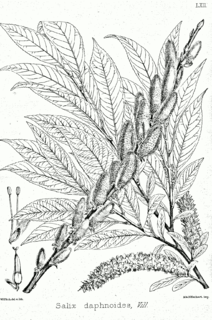
Salix daphnoides, the European violet willow, is a species of plant in the family Salicaceae. It can grow as a large shrub or small tree, normally reaching a height of 6–8 m (20–26 ft), but can grow up to 12 m (39 ft) tall.























